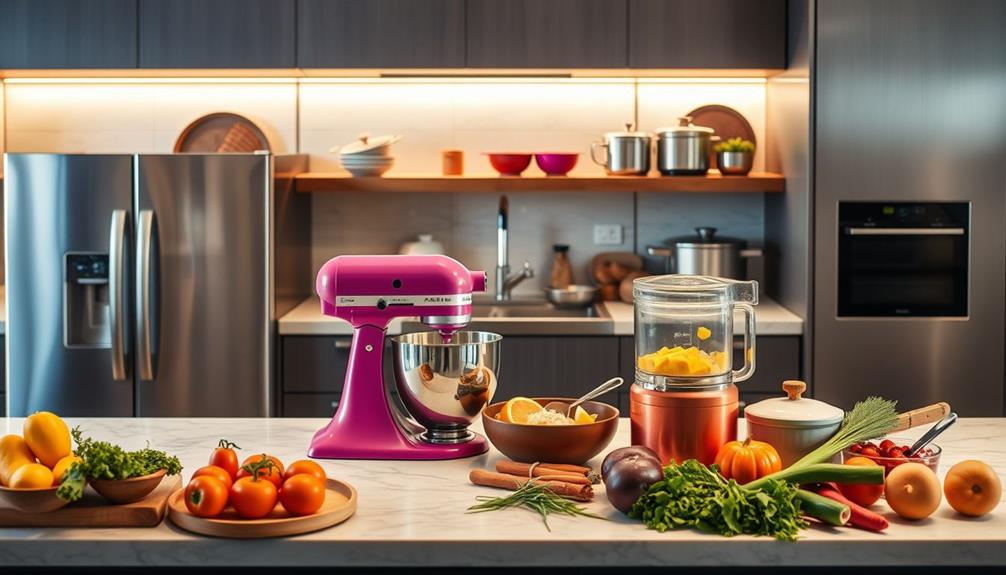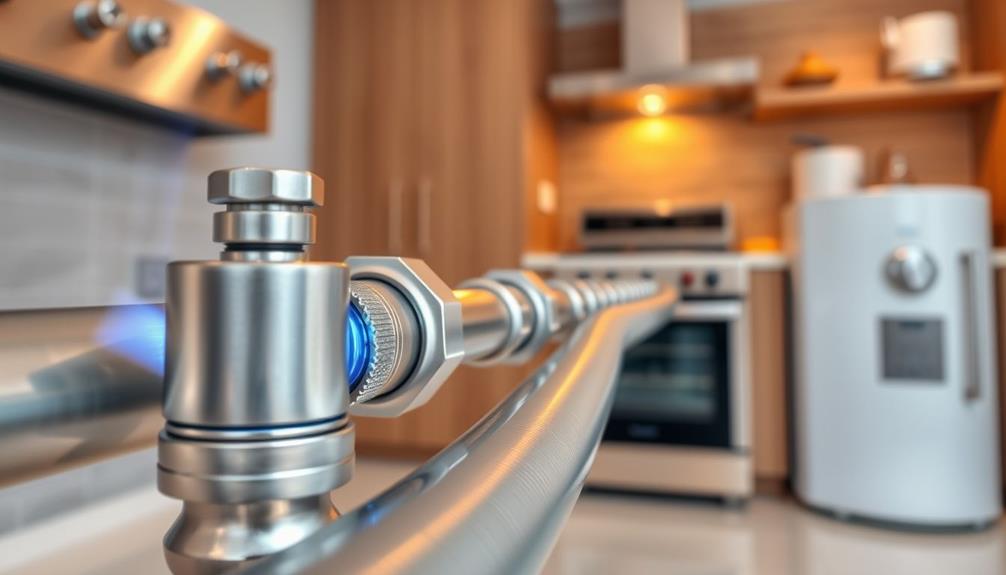Bidet seats and washlets use various heating methods to keep water warm and enhance comfort. Tank models store preheated water for quick use but can be bulky and less energy-efficient. Tankless or instant systems heat water on demand, saving energy and enabling slimmer designs. Hybrid systems combine both. Your choice affects energy use, size, and convenience. Explore further to discover how these technologies can optimize comfort and efficiency in your bathroom.
Key Takeaways
- Bidet seats use instantaneous, reservoir, hybrid, or water heater models to heat water, affecting energy consumption and user experience.
- Instantaneous and tankless systems heat water on demand, reducing energy use but may have slight startup delays.
- Reservoir systems store preheated water, consuming more standby energy but providing quick access to warm water.
- Hybrid heating combines storage and instant heating for reliable, continuous warm water with moderate energy use.
- Proper installation and energy-efficient heating technologies optimize power use and enhance overall bidet seat performance.
Overview of Heating Technologies in Bidet Seats

Heating technologies in bidet seats vary primarily between instantaneous (on-demand) systems and reservoir (tank) systems, each offering different benefits. Instantaneous systems heat water instantly when you start the wash, using a heating coil built into the seat. This guarantees a continuous supply of warm water without depletion, providing a sleek and efficient experience. These units often produce a brief cold burst at the start due to residual water, but it’s usually unnoticed. Instant systems are common in higher-end bidets because of their complexity and quality. In contrast, reservoir systems contain a small tank that stores pre-heated water, which can run out during continuous use. While simpler and more affordable, reservoir units may experience temperature fluctuations as the water cools or needs reheating. Reservoir systems may also be less energy-efficient because they keep water heated constantly or require reheating between uses.
How Tank Type Water Heaters Work and Their Benefits
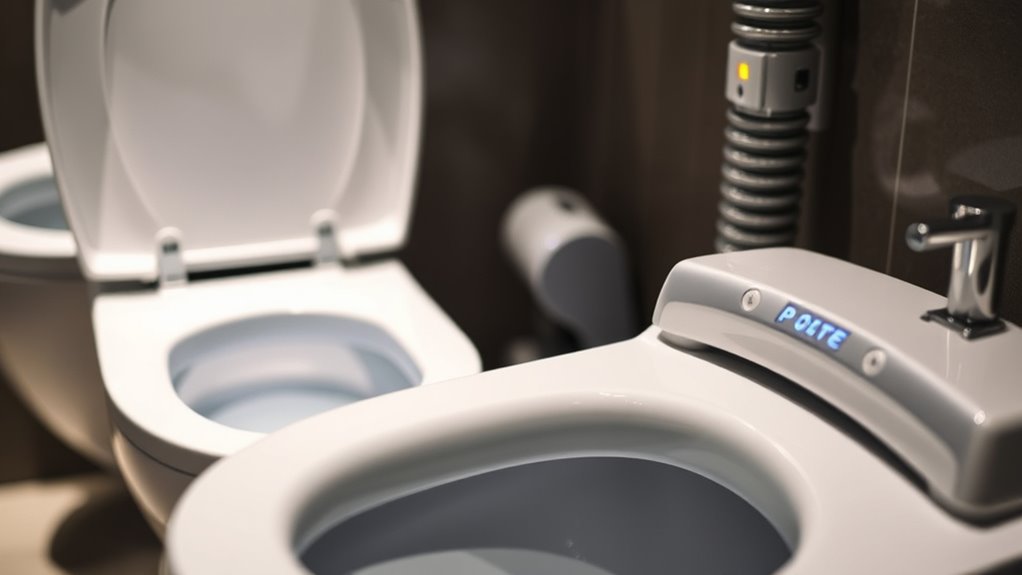
Tank-type water heaters operate by storing hot water in a tank, ready to meet your household’s needs instantly. Cold water enters through a dip tube at the bottom, where it’s heated by a gas burner or electric elements. Hot water naturally rises to the top of the tank, ready to be drawn off when you turn on a fixture. A thermostat controls the temperature by switching the heater on or off as needed. When hot water exits, cold water enters to replace it, maintaining pressure. Gas models use a burner with safety features like flame sensors, while electric models rely on thermostatically controlled heating elements. Insulation minimizes heat loss, but energy continues to be used to keep water hot, leading to standby heat loss. Proper insulation can significantly reduce heat loss and improve efficiency.
Advantages and Drawbacks of Tankless (Instant) Systems

Tankless bidet systems offer the benefit of unlimited warm water and a sleek, space-saving design that fits easily into modern bathrooms. However, they can have higher upfront costs and introduce a slight delay as warm water begins to flow. Considering these factors helps you decide if their advantages outweigh the initial investment and startup time. Additionally, juice cleansing can be a beneficial way to support overall wellness, but it’s important to be aware of potential side effects and nutritional considerations. Proper system installation and maintenance are essential to ensure optimal performance and longevity of your bidet system.
Unlimited Warm Water Supply
Have you ever wondered how some bidet seats provide endless warm water without a tank? It’s due to instant heating on demand, where water is heated only as it flows through the heating element during use. This means you get continuous warm water during your entire wash, even if it’s prolonged. Without a reservoir, there’s no risk of stale water or bacterial buildup. Plus, it’s more energy-efficient since heating only occurs when needed, reducing standby power waste. Additionally, tableware materials used in manufacturing these systems can influence durability and heat retention. The electricity consumption of these systems can be significant during peak use, which is an important factor for energy-conscious users. However, there’s a brief cold water burst at the start, and peak wattage demands can be high, sometimes requiring dedicated electrical circuits. While maintenance is simpler—no tank to scale—initial costs are higher, and power interruptions mean no warm water until restored. Still, many users find the endless supply worth the investment.
Compact and Sleek Design
The absence of a bulky water tank allows bidet seats to boast a slim, low-profile design that fits seamlessly into modern bathrooms. This compact form means you can install them in tight spaces or smaller bathrooms without sacrificing style or comfort. Plus, wall-mounted installation frees up valuable space, making your bathroom appear cleaner and more organized. The sleek design also eliminates the rear bulkiness seen in tank-type models, enhancing aesthetic appeal. Additionally, storage space can be optimized due to the minimal footprint of tankless systems. While the slim profile is a significant advantage, keep in mind that installation may require upgrades to plumbing or electrical wiring, which can add to upfront costs. The modern bathroom design trend often incorporates these streamlined fixtures to maximize functionality and visual appeal.
Cost and Initial Delay
While tankless bidet seats offer many modern benefits, their higher initial cost can be a significant consideration. They generally range from $800 to over $2200, reflecting advanced features like on-demand heating, UV sterilization, and motorized lids. This premium price may seem steep upfront, but some models provide better durability and energy efficiency, potentially saving money over time. Unlike tank-type systems, tankless units deliver continuous warm water without needing to wait for reheating, meaning no delays after each use. You might notice a brief cold water spurt at the start, but it’s usually imperceptible. Keep in mind, the initial expense is higher, but the convenience of instant, endless warm water and modern features can outweigh the costs for many users. Additionally, energy efficiency is a key benefit of tankless systems, helping to reduce overall electricity consumption.
Hybrid Heating Systems: Combining Efficiency and Performance
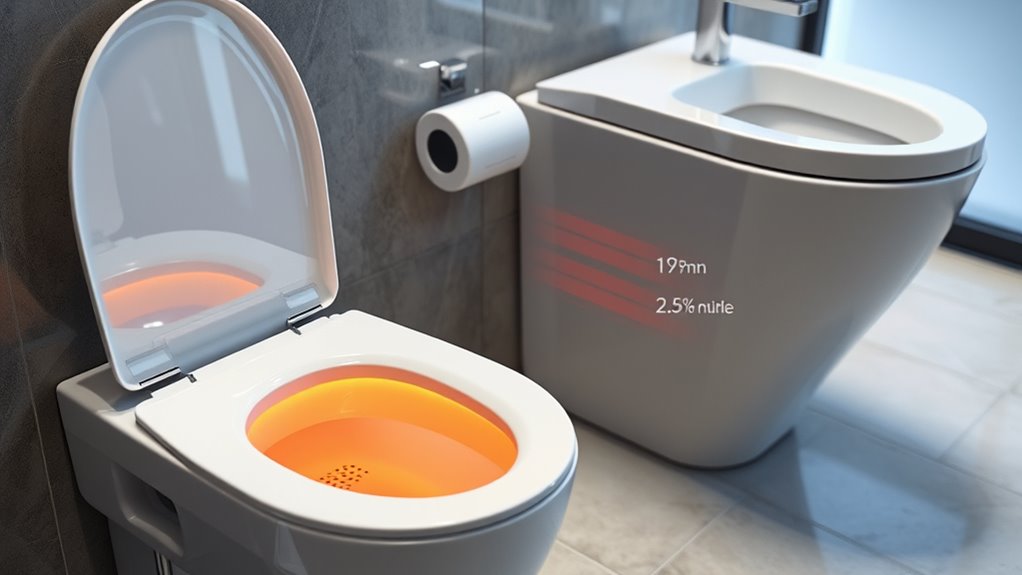
Hybrid heating systems in bidet seats blend the benefits of reservoir storage and instant heating, offering a seamless supply of warm water without sacrificing efficiency. You get unlimited warm water during each use, thanks to the small preheated tank combined with continuous heating coil technology. This setup reduces bulk compared to traditional tank systems and prevents temperature drops during extended cycles. Additionally, easy maintenance ensures the system remains reliable over time. The use of energy-efficient technology in these systems further minimizes power consumption and operational costs. Highlights include: – Consistent water temperature for longer or multiple wash cycles – Higher spray pressure due to combined stored and instant-heated water – Lower energy consumption by heating small water volumes efficiently This hybrid design balances convenience with energy savings, delivering reliable warmth and performance without the drawbacks of purely tank or tankless systems.
Energy Consumption Patterns of Different Heating Methods
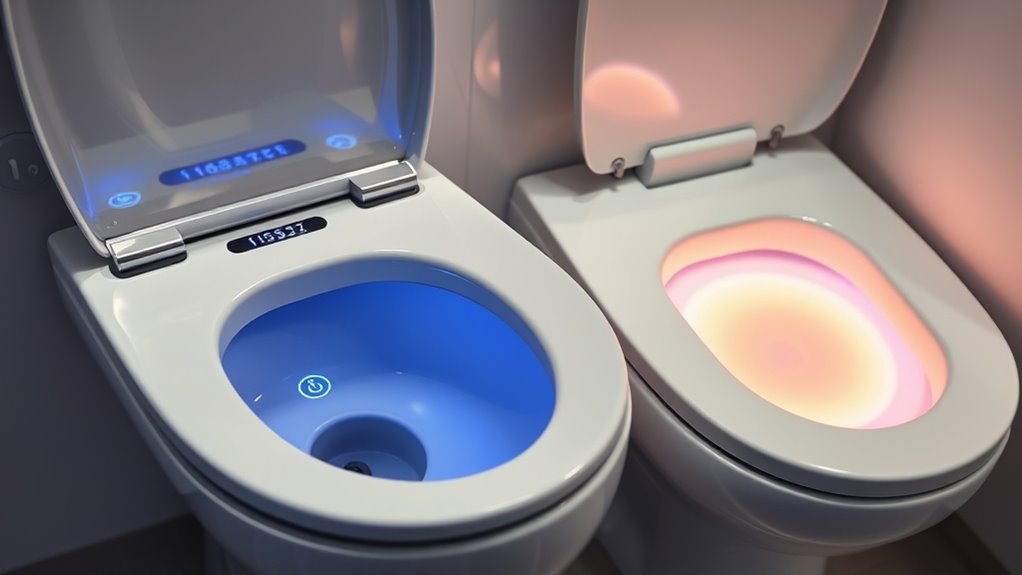
Understanding how different heating methods impact energy consumption is key to choosing the most efficient bidet seat. Tank systems store preheated water, which leads to continuous energy use to maintain temperature, resulting in higher standby power consumption. In contrast, tankless systems heat water on demand, only using energy when you activate the bidet, making them more efficient overall. Hybrid systems combine both approaches, balancing storage and instant heating, often reducing standby energy loss. While tank heaters may cost less upfront, their constant energy draw can increase utility bills over time. Tankless models, like Toto Washlets, deliver unlimited warm water while consuming less energy during idle periods. Additionally, some arcade machines utilize advanced heating methods for their internal components to ensure consistent performance and longevity. Your choice depends on balancing initial costs, energy savings, and usage patterns, and considering the overall efficiency of the system can lead to significant savings.
Effects of Heating Choices on User Experience and Comfort
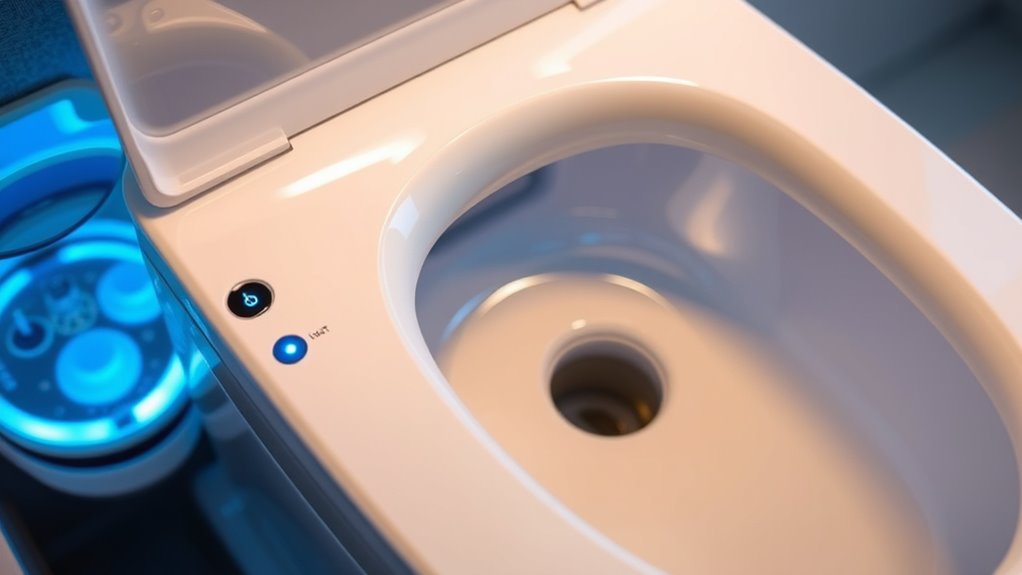
The way your bidet seat heats water directly influences your comfort during use. Consistent and stable water temperature enhances your hygiene routine by preventing sudden cold shocks. Hybrid and instant heaters provide uninterrupted warmth, supporting longer or more thorough washes, increasing satisfaction. In contrast, tank heaters may cause abrupt temperature drops if the reservoir runs out, reducing comfort. Small cold bursts from instant heaters are usually barely noticeable but might affect sensitive users. Adjustable temperature settings allow you to customize warmth, further improving comfort. Additionally, understanding heating methods can help you select a bidet seat that best meets your comfort preferences. Knowing how different AI technologies are integrated into smart bathroom devices can also influence your choice, ensuring safer and more reliable operation.
Installation Considerations for Various Heating Options

When installing a bidet seat with heating features, you need to consider both power supply requirements and plumbing compatibility. Some models require a dedicated GFCI outlet, while others can share a circuit with your bathroom fixtures. Ensuring proper water line connections and electrical access will help you achieve a safe and effective installation. Additionally, energy monitoring features can assist in managing power consumption and avoiding overloads.
Power Supply Requirements
Proper power supply setup is essential for safe and reliable operation of bidet seats with heating features. You need to verify your outlet meets specific requirements to avoid safety hazards and ensure proper function.
- Use a GFCI-protected 3-prong grounded outlet rated for at least 15 amps to protect against electrical shock.
- The outlet should provide 120 volts, standard in most bathrooms, and be located within 4 feet of the toilet for easy connection.
- Consider the cord extension direction—most cords extend from the right, so outlet placement should accommodate this.
Additionally, consult a licensed electrician for new installations or remodels to ensure compliance with electrical codes and safety standards. Proper setup guarantees safe, efficient operation. Electrical safety standards are critical for preventing hazards and maintaining proper functioning of your bidet seat.
Plumbing Compatibility Needs
Different heating options in bidet seats influence how your plumbing needs to be configured. Most units connect to your existing cold water line using a T-valve splitter, which reroutes water to the bidet without new plumbing. You’ll need to shut off the main water supply, detach the current seat lines, and install the T-valve, ensuring supply hoses are tightly sealed with plumber’s tape to prevent leaks. Compatibility varies with toilet types; elongated bowls usually fit better, while round bowls may require careful measurement. Electrically heated seats need both water supply and electrical wiring, but plumbing modifications are minimal since heating occurs internally. Most bidets don’t require additional drainage, but proper backflow prevention with check valves helps maintain water safety standards. Additionally, understanding automation’s role in business intelligence can help optimize installation processes and maintenance scheduling. In some cases, plumbing compatibility checks are necessary to ensure the bidet seat fits your existing toilet setup.
Design and Size Implications of Heating Technologies
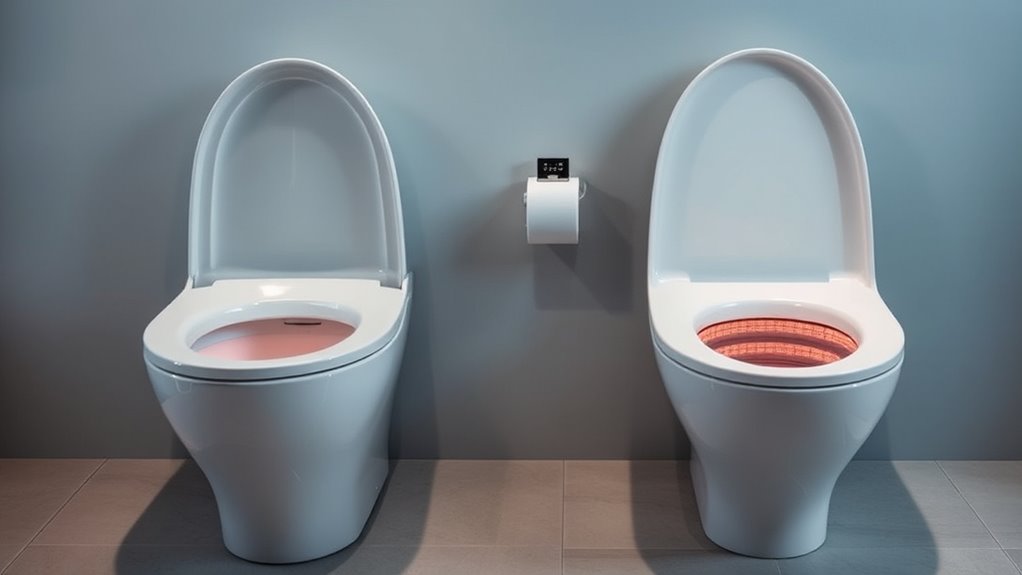
Heating technologies in bidet seats and Washlets substantially influence their design and size. Instantaneous heaters support slimmer profiles by eliminating bulky tanks, making seats more compact. Conversely, tank-based systems require deeper seats to accommodate reservoirs, increasing thickness by 1-2 inches. The choice of heating method impacts internal space, with electronic components and plumbing affecting overall cavity size. Larger heating elements and controls add to seat bulk and weight, influencing mounting and compatibility with various toilet models. Considerations include:
Instantaneous heating enables slimmer, more compact bidet seats by eliminating bulky reservoirs.
- Slim profiles use compact heating elements to save space.
- Tank systems increase seat thickness and overall size.
- Internal wiring and components influence seat cavity and installation clearance.
These design constraints ensure functionality without compromising comfort or fit. Understanding prophetic dreams can also reveal insights into subconscious influences that shape perceptions of one’s environment and technological choices. Additionally, the energy efficiency of different heating methods plays a crucial role in long-term operational costs and environmental impact.
Cost Factors and Long-Term Savings of Heating Systems
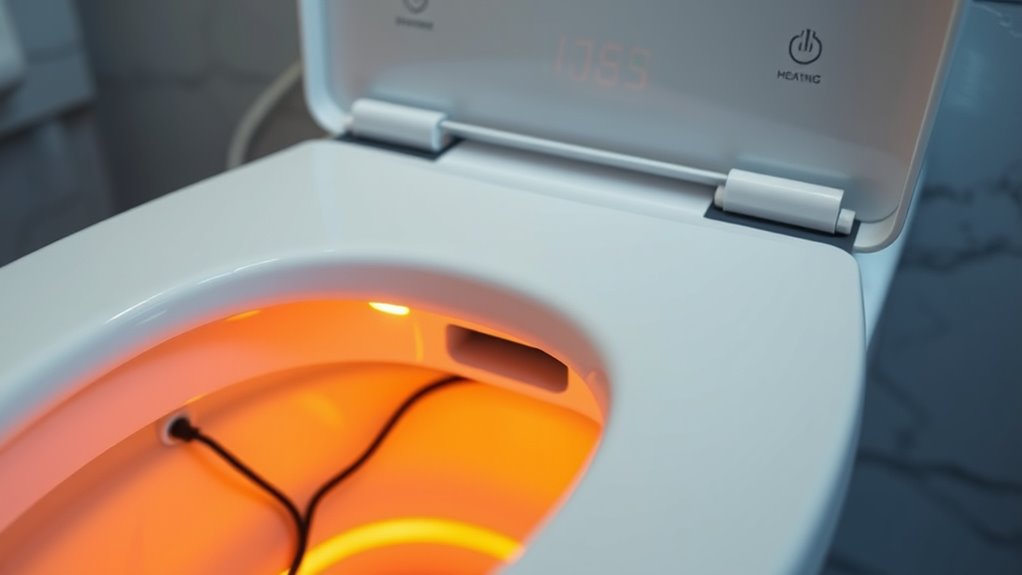
When choosing a heating system for your bidet seat, installation costs can vary markedly, especially with high-power models that need dedicated wiring. Over time, energy savings from tankless or hybrid systems can offset higher initial expenses, saving you money on electricity bills. Maintenance and replacement costs also impact long-term value, with simpler designs generally requiring less upkeep.
Installation Costs Comparison
Are you wondering whether the initial costs of installing bidet seats or washlets are worth the long-term savings? Installation costs vary widely, influenced by the type and complexity. For example, bidet seats cost between $250 and $1,000, while standalone models can reach $2,600. Bidet attachments are affordable at $100–$300, and washlets typically fall between $470 and $1,700. Full toilet replacements range from $1,200 to $2,000.
Key factors include:
- Bidet Type: Attachments are cheaper than standalone or full systems.
- Plumbing Needs: Modifications increase costs.
- Professional Installation: Ensures proper setup but adds expense.
Additionally, incorporating aesthetic wall organization systems can enhance bathroom decor while maintaining functionality. These systems can also help conceal plumbing fixtures, reducing visual clutter. Ultimately, these initial investments can be offset by long-term savings and benefits.
Energy Savings Potential
Understanding the energy consumption of different heating systems in bidet seats and washlets helps you evaluate their long-term savings. Tank-type heaters keep water warm continuously, but waste energy when not in use. Tankless systems heat on demand, saving energy during infrequent use but may cost more during heavy use. Hybrid systems strike a balance, providing faster warm-up with moderate energy use. Heated seats draw low, constant power, contributing more to idle energy consumption than water heating. Proper installation and venting techniques are essential to optimize energy efficiency and safety in these systems.
Maintenance and Replacement
Maintaining and replacing bidet seats involves both initial costs and ongoing expenses that can impact your long-term savings. Regular maintenance, such as cleaning the seat, wand, and filters, is essential for peak performance. Parts are readily available from manufacturers or authorized dealers, making repairs manageable. Some tasks, like cleaning, can be DIY, while others may need professional help. Be sure to consider warranty coverage, which can save you money on repairs.
Key points to consider:
- Replacement parts are easy to source, reducing downtime.
- Proper maintenance extends the lifespan of your bidet seat.
- Warranties can substantially lower long-term repair costs.
Investing in quality models with good support can maximize your savings over time.
Trends and Innovations in Bidet Seat Heating Technologies
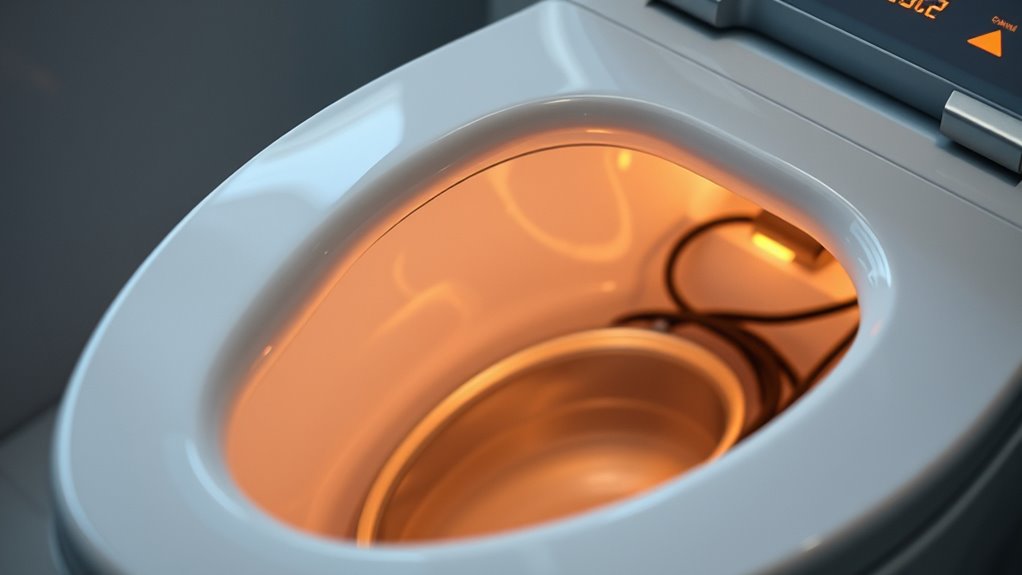
Recent advancements in bidet seat heating technologies focus on enhancing comfort while reducing energy consumption. Instantaneous heating and tankless designs heat water only when needed, cutting energy use and saving space. Heated seats remain popular for comfort, while smart controls enable precise temperature adjustments and optimize energy efficiency.
| Technology | Benefits |
|---|---|
| Instantaneous Heating | Reduces energy by heating water on demand |
| Tankless Systems | Minimize energy and space requirements |
| Smart Controls | Allow personalized settings and energy optimization |
| Eco-Friendly Materials | Promote sustainability and eco-conscious design |
These innovations make bidet seats smarter, more efficient, and more comfortable, aligning with modern needs for sustainability and personalized user experience.
Frequently Asked Questions
How Do Heating Methods Affect Bidet Seat Durability?
Your bidet seat’s heating method substantially impacts its durability. If it uses a tank water heater, the constant thermal stress can wear out components faster and increase maintenance needs. Instant (tankless) systems reduce wear by heating water only when needed, extending their lifespan. Hybrid models balance these effects, offering better longevity. Proper thermal management and insulation also help prevent overheating, ensuring your seat remains durable over time.
Are Hybrid Systems More Energy-Efficient Than Tank or Tankless Models?
You might think hybrid systems are the energy champs, but surprise—they’re only more efficient than tank models, not tankless ones. While they balance performance and power use, they still keep a small preheated water reserve, which wastes some energy. So, if you want maximum efficiency, go tankless. Hybrids are just the middle ground, offering decent comfort without the energy savings of the truly efficient, instant-heating systems.
Can I Upgrade My Bidet’s Heating System Later?
Yes, you can upgrade your bidet’s heating system later, but it depends on your current model. If your seat has a removable or upgradeable heating module, you may add or improve heating features. However, many upgrades require replacing the entire seat, especially when switching to advanced instant or hybrid systems. Always check compatibility, electrical capacity, and consult professionals if needed to guarantee a smooth, safe upgrade.
What Maintenance Is Required for Different Heating Types?
You need to regularly inspect and clean your bidet’s heating system. For electric models with instant water heating, descale and check wiring, nozzles, and filters. For water tank types, flush and clean the tank, check for leaks, and replace filters. Non-electric models require monitoring plumbing, cleaning filters, and flushing lines. Always unplug before maintenance, use gentle cleaners, and schedule professional inspections if you notice issues.
Do Heating Methods Impact Bidet Seat Noise Levels?
Did you know that tank-type heated bidet seats can produce up to 50% more noise than tankless models? Your heating method definitely impacts noise levels—tank-type heaters can be noisy when filling and heating water, while tankless systems operate more quietly since they heat water on demand. If you want a quieter experience, opt for tankless models, especially those designed for ultra-silent operation, and adjust settings to reduce noise and energy use.
Conclusion
Choosing the right heating method for your bidet seat is like tending a delicate garden—you want efficiency without sacrificing comfort. Tank, tankless, or hybrid systems each have their own seasons of benefit, but your decision blooms best when aligned with your needs. Remember, the true warmth lies not just in the technology, but in how it enhances your daily routine—turning simple moments into a sanctuary of care and renewal.



